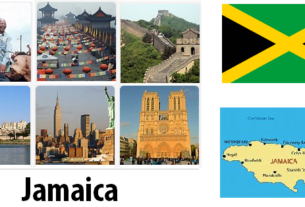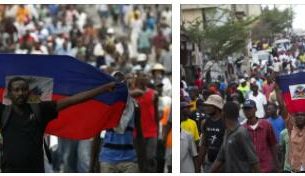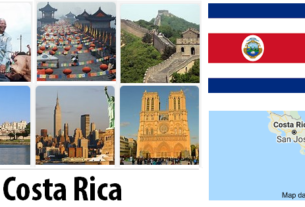SANTO DOMINGO
According to thesciencetutor, the capital of the country is the city of Santo Domingo. It is the oldest city in the New World founded by Europeans. It was founded in 1496. Santo Domingo is located on the south coast of the country. The oldest part of Santo Domingo – “Colonial City” – Declared a World Heritage Site by UNESCO. Here are the buildings of the 15th-16th centuries, many of which were erected during the life of Christopher Columbus and are the first buildings of Europeans in the New World. Here are the Columbus Palace (Alcazar de Colon), built by the son of Christopher Columbus in 1510, the Osama fortress (1508) with the Torre del Omenahe tower, the Church of Santa Maria la Menor (the oldest church in America), which was erected at the beginning of the 16th century, and the ruins of the ancient monastery of San Francisco (beginning of the 16th century). Also to the most significant buildings of Santo Domingo include the oldest University in the region (1538) and the first St. Nicholas Hospital on the continent (beginning of the 16th century). In the “Colonial City” it is worth visiting the Plaza de la Cultura area, where the city’s most popular museums and the buildings of the National Theater and the National Library are located. Here are the Museum of the Royal Palace (Casas Reales), the Museum of Modern Art (the largest in the Caribbean), the Museum of the Dominican People, the Museum of Fine Arts and the National Museum of History and Geography. In the eastern part of Santo Domingo in the Mirador del Este park, on a high hill, stands the main symbol of the city – Columbus Lighthouse (Faro o Colon). Close to Los Tres Ojos National Park (Los Tres Ojos National Park) with three caves, at the bottom of which there are lakes, and Aquarium. Santo Domingo is considered one of the shopping centers in the Caribbean, as shopping centers are scattered throughout the city. The city’s main shopping areas are the waterfront Malecón Avenue, Condé Street, Duarte Avenue and Modelo Market.
CIBAO
The vast northern part of the Dominican Republic, located south of the “Costa del Ambar” and occupied by the ridges of the Cordillera Central mountain system and fertile valleys, is called Cibao, which means “mountainous lands” in the language of the Taino Indians. Cibao has been the center of the country’s agriculture and tobacco industry since colonization. Cibao is also the birthplace of the national merenge music.
The largest city of Cibao – Santiago de los Caballeros (Santiago de los Caballeros), which is simply called Santiago – is located in a picturesque valley in the foothills of the Cordillera Central. The history of the city dates back to the moment when Christopher Columbus decided to build a fort here in 1495. Later, these fertile lands began to attract more and more people and now Santiago is the second largest city in the Dominican Republic. In Santiago is the Cathedral of the late 19th century. Also of interest here is the monument to the Republican heroes (1940), which was built by order of the dictator Trujillo in his honor. The 67-meter monument stands on the highest hill in the city. There is a staircase leading to the monument, climbing which you will enjoy an excellent view of the entire city. Cultural Center “Centro Leon” is considered one of the largest exhibition venues in the country, exhibitions of art masters from all over the world are held here and concerts are given. Also of interest are the folkloric Museum of Thomas Moray with a wonderful collection of carnival masks, the Tobacco Museum, the Bermudez rum factory and the Leon tobacco factory. Jimenez. Be sure to go for a walk in the largest park in the city – Duarte – or along Calle del Sol, where shops, restaurants, hotels and modern office buildings are located.
The surroundings of Santiago are very picturesque. The city is surrounded by mountains and tobacco, coffee and cocoa plantations. A little east of Santiago is the city of Moca, which is considered the capital of the coffee production of the republic. In addition to coffee and cocoa plantations, the city church, made in the best traditions of Italian architecture, is interesting. In the vicinity is the city of Concepcion de La Vega (Concepcion de La Vega), where annually in February the most colorful and spectacular carnival of the Dominican Republic takes place. “Vegano”. Further south in the mountains of Cordillera Central, two cities worth visiting are Jarabacoa and Constanza. They are the centers of ecotourism and hiking in the country and because of their mild mountain climate are called “Cities of Eternal Spring”. From Jarabacoa and Constans, the most popular hiking trails along the Cordillera Central and to the highest peak of the Caribbean – Duarte (3187 m) originate. There are two national parks on the slopes of Mount Duarte – Jose Armando Bermudez national park and Jose del Carmen Ramirez. (Jose del Carmen Ramirez national park). Near the cities of Jarabacoa and Constanza, mountain rivers flow, on which picturesque waterfalls form. The most beautiful waterfall at Jarabacoa is El Salto Jimenoa, and at Constanza – Salto de Aguas Blanco. In addition, near Constanza there is a protected mountain valley Nuebo (Valle Nuevo) – the geographical center of the country, where pine forests and Dominican magnolias grow, and the Ebano Verde reserve with ebony trees unique to this region.



